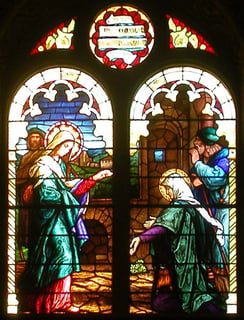 It’s the kind of scenario I could just see my girlfriends and I gushing over -- two cousins in a sweet reunion enjoying the fact that they are both going through a pregnancy at the same time!
It’s the kind of scenario I could just see my girlfriends and I gushing over -- two cousins in a sweet reunion enjoying the fact that they are both going through a pregnancy at the same time!
In those days Mary arose and went with haste into the hill country, to a city of Judah, and she entered the house of Zechariah and greeted Elizabeth. And when Elizabeth heard the greeting of Mary, the babe leaped in her womb; and Elizabeth was filled with the Holy Spirit and she exclaimed with a loud cry, "Blessed are you among women, and blessed is the fruit of your womb! And why is this granted me, that the mother of my Lord should come to me? For behold, when the voice of your greeting came to my ears, the babe in my womb leaped for joy. And blessed is she who believed that there would be a fulfillment of what was spoken to her from the Lord." (Luke 1: 39-45.)
On May 31, the Catholic Church celebrates the Feast of the Visitation of the Blessed Virgin Mary.
In this powerful encounter, two women -- Mary, now miraculously pregnant with the Christ Child, and Elizabeth, whose maternity carried his forerunner John the Baptist -- get their first look at one another after being separated by time and distance. But there’s more going on than a happy family reunion… there’s supernatural history being made!
Prior to this visitation, Mary received a miraculous visit from an Angel of God. On that day Mary not only received the good news of her own maternity, but the Holy Spirit overshadowed her and she conceived the God-Man in her womb. Then, the Angel went on to explain the similarly almost-impossible-to-believe baby news of Mary’s older cousin Elizabeth who suffered from a lifetime of infertility. Indeed, both women had miracles to share! (See the annunciation account in Luke 1: 26-37.)
Luke’s Gospel, therefore, has a few different stories going on all at once…
First there’s the story of these two women who are family. The younger one, Mary, takes great pains, given her times and condition, to travel the distance between her home in Nazareth to the hill country in Judah. Still, she undertakes the journey in order to share in Elizabeth’s joy -- and her own -- to do what women do -- take care of each other when a baby is due. For Elizabeth is already six months along and there’s much to prepare!
This is the dynamic that many women recognize -- the “nesting” that accompanies the birth of a first child. What a boon to Elizabeth her cousin Mary must have been.. to have a young, vibrant, and deeply spiritual woman around the house for three months as her newborn arrives. And then Mary, newly betrothed to Joseph, who will benefit from the elder Elizabeth’s loving mentoring and wisdom as she adjusts to her new life as wife and mother.
You can just picture it, right?
This scene was just Day One of a great sisterhood that would fill the next three months, a kind of “working retreat” for these two who loved and served each other as kinswomen: Women who will share countless conversations over the cooking and the household chores as they discuss the mysteries of life together. There would be time to pray and ponder, as they work side by side to prepare for their babies. And these were preparations for no ordinary babies. Foretold by the Prophets, these sons would grow to be men with a Godly mission that would change the world. In fact, we already get inklings from Luke that the world has already changed.
The second story being played out in this biblical account is on a spiritual plane. For besides the story of the visitation between these two holy women, there is the story of their two sons in utero who “meet” and “greet” each other in a supernatural way. It seems uncanny and miraculous.
Mary, already the theotokos – the “God-bearer” – brings Jesus into the home of Zechariah and Elizabeth. Then the child in Elizabeth’s womb “leaps for joy” in a supernatural recognition of the presence of the long-awaited Messiah. Even from the womb, John, the soon-to-be-herald of the Christ, begins his ministry of preparing the way for Jesus, by “announcing” that he is come, as his mother verbalizes the sentiment.
Further, Luke’s Gospel is embedded with language that echoes the Old Testament stories of King David’s processions and prayers – with leaping and dancing for joy – before the Ark of the Covenant, the ancient tabernacle of the Presence of the Most High God. (See 2 Sam 2: 6, 16, 1 Chron 15:26, 16: 4-5.) This is why scripture scholars have, for centuries, called the Blessed Virgin Mary the new Ark of the Covenant.
And now we see a new order contained in Elizabeth’s marvelous Spirit-inspired greeting of Mary: "Blessed are you among women, and blessed is the fruit of your womb! And why is this granted me, that the mother of my Lord should come to me?”
Here is yet a third layer to the same story…
Elizabeth’s exclamations proclaim two truths in tandem: that Jesus is the Lord, and that Mary is the Mother of the Lord.
In the former, we see fulfillment of God’s Word, of his promises to the Prophets to be with His People through a King that would be born. This is Jesus, the Lord -- the long-awaited Anointed One of Israel whose presence every Jew longed for! Jesus now comes to the earth, recognized by John and Elizabeth, yet hidden from view in the sanctity of Mary’s womb. Elizabeth doesn’t guess Mary’s secret, she is given spiritual knowledge of this truth, just as her baby knew it and proclaimed it by his movements.
Finally, there’s a fourth level to this story. Elizabeth recognizes that this visitation not only declares something special about Jesus, but she also proclaims the truth about Mary. Centuries later, her words would be confirmation by the Church of what it already knew as the first Marian dogma -- thanks to the Angel’s message to Mary -- Mary is the Mother of God, the theotokos. A dogma is never a new idea, or something the Church invents; no, it is only the Church’s confirmation of what already exists as a profound truth.
Elizabeth first uses the words that we use today to describe Mary: she is “blessed” among women. She is not only the most graced woman of all, but she is also the happiest of all: her Son Jesus bestowed that joy on her by his presence in her womb. Elizabeth echoes it with her words. And we recall it every time we pray the “Hail Mary” prayer.
Following Elizabeth’s greeting, Mary breaks out into the song, or canticle, that we know as “The Magnificat”. Her heart is bursting with joy…
My soul magnifies the Lord,
and my spirit rejoices in God my Savior,
for he has regarded the low estate of his handmaiden.
For behold, henceforth all generations will call me blessed;
for he who is mighty has done great things for me,
and holy is his name. (Luke 1:46-49.)
You could say that, in the Visitation, Mary makes the first missionary journey… she joyfully brings Christ to the world… the first stop being the home of Zechariah, Elizabeth, and soon-to-be-born John. You could also say that Mary, as a good mother would, finds personal joy in sharing the Lord’s presence with us, whenever we invite him into our hearts and homes.
But Mary’s greatest joy will be sharing Christ’s presence with us in the fullness of joy that is our heavenly home. Then the true fruits of her Visitation will be realized.
©2011 Patricia W. Gohn
About the Author

Pat Gohn
Pat Gohn is a married empty-nester with three adult children and four grandchildren. An author, catechist, speaker, and host of the Among Women podcast since 2009, her books include the award-winning Blessed, Beautiful, and Bodacious: Celebrating the Gift of Catholic Womanhood, and All In: Why Belonging to the Catholic Church Matters. She works in Catholic publishing as an editor. Visit PatGohn.net


.png?width=1806&height=731&name=CatholicMom_hcfm_logo1_pos_871c_2728c%20(002).png)
Comments